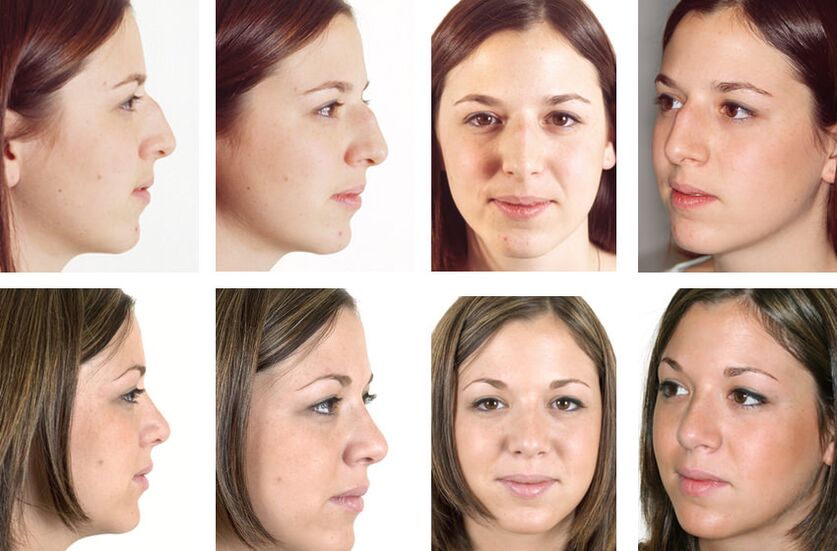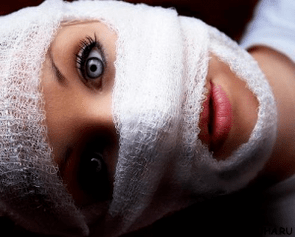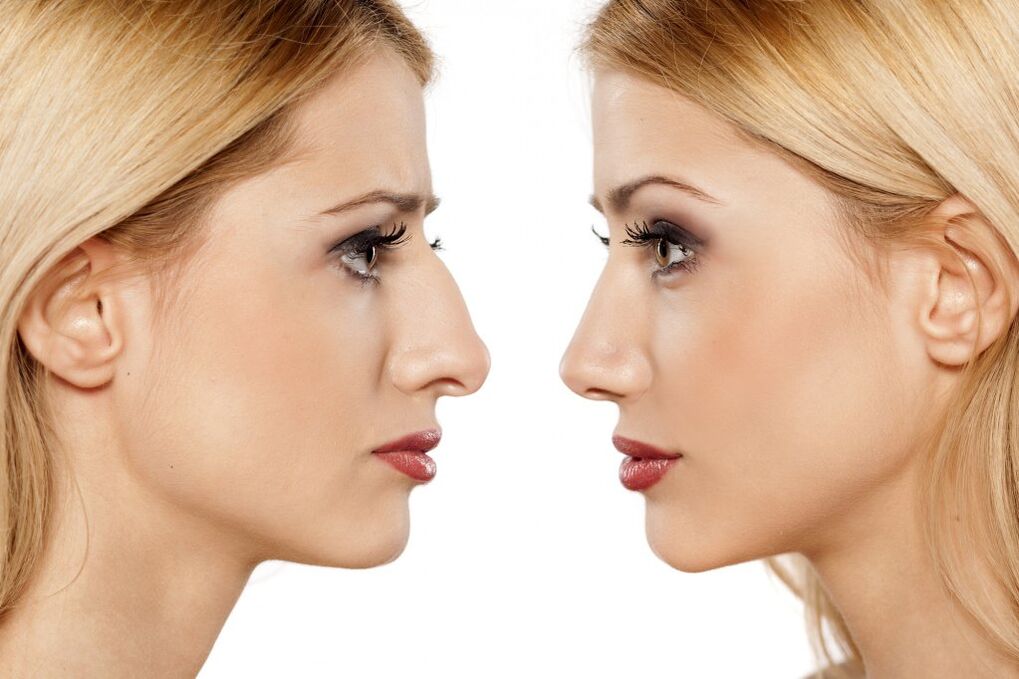Rinoplasty is a special surgical operation, which is performed to correct congenital or acquired nasal defects, as well as a total increase in the missing parts of the nose.
The rhinoplasty operation is in the fact that the surgeon changes the nasal parameters due to invasion of the bone-chrashny nasal frame.
The main task of this operation is to return the correct form of the nose to a person who was raped even before birth, due to diseases or through acquired nose injury.

Types of rhinoplasty
Today, the world uses these types of nose rhinoplasty:
- septoplasty;
- closed rhinoplasty;
- open rhinoplasty;
- rhinoplasty on secondary behavior;
- rhinoplasty without surgery;
- rhinoplasty when using fillings;
- rhinoplasty using special auxiliary drugs;
- Rhinoplasty with apt threads.
Septoplasty
Septoplasty is a surgical intervention that is established in the task of eliminating defects in the nasal septum: the displacement of the cartilage and the bones, which interfere with the normal functions and the type of aesthetic nose.
Indications for septoplasty for humans:
- Constant nasal congestion without apparent reason;
- snore;
- nasal development defects or nasal partitions;
- constant or periodic nasal bleeding;
- the presence of chronic sinusitis;
- general deformation of the nose;
- The consequence of the nose injury that prevents normal respiratory function.
Contraindications to septoplasty:
- the presence of diabetes;
- Too much distortion of the nasal septum;
- The presence of cardiovascular system diseases.
Closed rhinoplasty
Closed rhinoplasty as an operation is easier to tolerate by a patient than open rhinoplasty. This procedure is carried out by endonasal access to the nose, that is, the cuts are made directly inside the nose.
This operation has a series of advantages for the patient, but it is extremely inconvenient for the surgeon, since it is easier for any surgeon to perform surgery in a well -accessible operating field. Consequently, in closed rhinoplastic there are many more possibilities to obtain a medical error, as a result of what complications or other problems in the patient they can occur.
Advantages of closed rhinoplasty:
- The duration of the operation is much lower compared to open rhinoplasty;
- The nasal fabrics are not cut on the surface of the nose and the cuts of smaller size;
- less likely to the appearance of scars;
- smaller edema after surgery;
- The result of the operation is visible a few days before.

Indications for closed rhinoplasty:
- Aesthetic (curve, ugly form of the nose, deformation of the nose, etc. );
- Doctor (nose injury, lack of breathing due to the incorrect structure of the nose).
Contraindications to this type of operation:
- the presence of mental illness in the patient;
- inadequacy of the wishes of the patient's final result;
- the presence of diseases in which any rhinoplasty is contraindicated;
- The implementation of the patient of several failed rhinoplastic before, which largely deformed the soft tissues of the nose.
Since closed rhinoplasty is a fairly complicated operation, after their behavior, the patient can have the following complications:
- inflammation of the nasal tissue;
- the formation of scars (rarely);
- the formation of pigmentation in the skin, which can remain forever;
- hemorrhage;
- nasal bleeding;
- swelling or bruises around the nose;
- Incorrect nasal form, which will require a secondary operation.
Open rhinoplasty
Open rhinoplasty, unlike a closed, is carried out with a small cut, with a diameter of 4 to 5 mm. Thanks to such a barely visible section, the skin of the nose can be completely raised and then the surgeon will be much more convenient to work with an open skeleton of the nose, because it will see in front of it the entire external structure of this organ, unlike the closed rhinoplasty. This greatly reduces the possibilities of a surgical error.
In addition, open rhinoplasty for the primary operation is recommended, since it can eliminate with greater precision all existing nose defects, unlike closed rhinoplasty, which cannot always guarantee the same result.
Rhinoplasty on secondary behavior
Secondary rhinoplasty is carried out if the primary was not successful and it is necessary to correct complications. It can be carried out both open and closed.
Rinoplasty without surgery
Rinoplasty without surgery is carried out only in 4-7 % of patients who can do without surgery. With your help, only minor nose defects can be corrected. The most serious problems in the structure and appearance of the nose require only a complete rhinoplasty operation.
Rhinoplasty when using fillings
This procedure is carried out if the patient wants to eliminate only minor nose defects. For example, these can be several minor disadvantages, defects, expansion of the tip of the nose, the incorrectness of its symmetry, etc. In these cases, doctors use special fillings that are introduced into the tissue of the nose and correct the problem.
The advantages of this method are that the restoration of the nose after it is much easier, and the procedure itself is not as painful as ordinary surgical intervention.
The disadvantages of rhinoplasty using landfills are a change in the structure of the nasal tissue and the possible "migration" on the surface of the nose of the administered medication.
Rinoplasty with special auxiliary drugs
To carry out this procedure, surgeons use special medications based on hormones that are introduced into defective nasal areas.
The advantage of said rhinoplasty is that the patient is not subject to surgical intervention. But a great disadvantage of this rhinoplasty is that with the inappropriate calculation of the dose of the medication and its introduction in the incorrect area in the nose, the patient can have several complications and deterioration of the defects.

Rhinoplasty using threads
This procedure is carried out using threads with which doctors pull the wings of the nose and nose. These threads are brought through special punctures in the nose and, so to speak, pull your nose.
Rinoplasty using threads is not very often used by surgeons, since it has a series of disadvantages:
- After the procedure, there is a great probability of scars formation;
- the occurrence of contour and the ugly type of nose in "points";
- The high probability of a break in the threads, because the nose is very mobile in its structure, which provides the lack of reliability of this procedure.
Pros and cons of rhinoplasty
The advantages of rhinoplasty:
- satisfaction with its appearance after surgery;
- complete elimination of any defect in a successful procedure;
- Improvement of breathing in their preoperative disorders.
Cons of rhinoplasty:
- the possibility of acquiring infection;
- loss of sensitivity to the nose;
- bleeding;
- Operation carried out without success, complications;
- deterioration in the appearance of the nose and dissatisfaction with the final result.
Indications and contraindications
If a person has congenital nasal defects, but can perform rhinoplasty with the beginning of adulthood. In general, the age of 18 to 40 is considered the most appropriate age for this procedure, when the body is already formed and a person makes a balanced decision.
Indications for rhinoplasty:
- the presence of a hump in the nose;
- congenital nasal defects;
- nasal defects acquired by injuries;
- rape or complete impossibility of breathing with the nose;
- Nostrils of volume too wide;
- The nose is too long;
- Nose in the form of a wrinkled chair;
- Addition nose similar to hook;
- Nose too thick;
- Nose too sharp.
Contraindications to rhinoplasty:
- human minority (if the injury was acquired as a child, then the procedure is possible in premature lines);
- Age after the quadgeth anniversary (since after this age, a person has the risk of all kinds of complications and worsens the wound healing process);
- the presence of diabetes mellitus;
- all kinds of kidney or liver diseases;
- problems with patient blood coagulation;
- severe heart disease and blood vessels;
- acute viral diseases;
- the presence of cancer diseases;
- the presence of mental disorders;
- If there are no nasal defects and rhinoplasty is simply not required.
Preparation for rhinoplasty
Since rhinoplasty is a complete operation, for some time before, the patient should do the following:
- Submit for a complete examination due to the presence of cardiovascular diseases.
- Pass the exams and take the therapist's advice, neuropathologist, Laura, anesthetist, surgeon who will perform the operation, etc.
- Discuss with the surgeon all possible consequences of the operation and determine the future form of the nose, the width, etc. , you must also discuss the type of anesthesia with an anesthesiologist, which you will use during operation.
- Pass all the necessary evidence.

Performing operations - Stages
Rinoplasty is carried out in these stages:
- The patient administers anesthesia;
- Additional anesthesia is carried out;
- After that, the surgeon makes an incision in the lower layer of the nose and begins directly to his work (said surgical intervention can be closed and open);
- The surgeon adjusts all the defects of the nose, correct irregularities, humps, etc. , depending on the specific problem of the patient;
- If necessary, you can replace the missing cars in the nose of your other areas or implement artificial cartilage;
- At the end of the operation, the surgeon sews his nose and imposes a fixing bandage.
Depending on the level of complexity and the course of the procedure, the operation of rhinoplasty can last 50 minutes to 2 hours. It should also be mentioned that the nose after surgery can undergo independent changes in the form of improvements or deterioration.
All this will depend on the patient, compliance with medical recommendations and directly, the results of the operation itself, which will be visible only after 6-8 months.
Rehabilitation period
After rhinoplasty, in the nose and around its region, a vaccine, swelling and bruises are formed, which usually go in two weeks. After surgery, a special fixing bandage is applied to the patient's nose, which should be used within ten days. Tampons will also be inserted into the nose, which will avoid bleeding, so that for some time the patient cannot breathe the nose.
The result of the operation can be evaluated in six months, and the final result is in one year. The delay of the wounds after surgery depends on each person individually and the state of their vitality. If complications are observed after the operation, then the healing lines can increase significantly.
After rhinoplasty, it is desirable to visit his surgeon to perform inspections of the nose after rhinoplasty.
Recommendations before and after surgery
Before the operation, the patient continues:
- abandon all bad habits (alcohol, fatty foods, etc. );
- A few days before surgery, medicines and products are prohibited, which causes a decrease in blood clotting in the body.
After surgery, the patient must meet the following requirements:
- In the first months after rhinoplasty, one cannot be involved in sports (gymnastics, race, etc. );
- It is not desirable to swim;
- Do not eat food too hungry or hot to avoid bleeding;
- Wash carefully, without touching the nose and areas around it;
- Avoid an abrupt change in facial facial expressions;
- Use the clothes that do not need to be removed on the head.

Possible complications after surgery
After rhinoplasty or during the procedure itself, the following complications can occur:
- Anesthesia allergy.
- Abundant nasal bleeding.
- The edema of the nose zone (in the first weeks after the procedure), which can interfere with normal nasal breathing.
- Swelling in the face (in the eyes, cheeks and other parts of the face).
- The appearance of bruises on the face.
- Reducing the sensitivity of the skin of the nose or its absolute loss for a time.
- The risk of infection infection.
- Large scars can be formed, to eliminate which operation will be needed.
- Difficult breathing after surgery (depending on the type of operation and procedures). Which will be carried out with nasal cartilage.
- The appearance of the absence of smell or its partial loss.
- Skin stretching or loss of its flexibility (occurs with excessive cutting cartilage in the nose).
- Narrow fabric.
- The formation of age spots or the manifestation of the blood vessels in the skin of the face.
- Fatal result with anaphylactic shock.
- Unsatisfaction of the patient with the final result of the procedure.
- Failed course of the procedure through the surgeon's failure.
Results
The first results of the operation will be visible after 10-14 days. But the patient can see the final result only after 8-10 months, when all numerous edema and bruises will go and the fabrics are "placed" in the new nose.
It often happens that family and friends do not notice significant changes in the patient's appearance after surgery. Since bruises and swelling will drown the whole result. In this case, the patient does not need to run immediately to repeated rhinoplasty, but should only be expected when the face reaches the usual way and then evaluate the final result.
In addition, it should be indicated that rhinoplasty does not give a genetic effect and will not be transmitted by the clan for children, as some patients may consider. This operation improves only the appearance of a person.




















